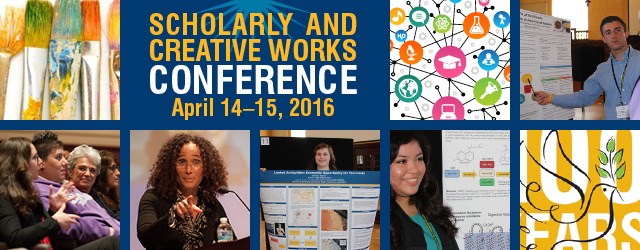
All Conference Presentations, Performances and Exhibits
Sunlight and UV Tanning Motivations
Location
Guzman Lecture Hall
Start Date
4-15-2016 4:30 PM
End Date
4-15-2016 5:30 PM
Student Type
Undergraduate
Faculty Mentor(s)
Michaela George, Ph.D., MPH
Presentation Format
Poster Presentation
Abstract/Description
Although some outcomes of interest regarding UV tanning have been studied in relation to skin cancer and aging (Grange 2015; Narayanan 2010; Saladi & Persaud 2005; Woo & Eide 2010), many have focused on high school and youth (Cokkinides et al. 2002; Karimkhani 2015; Savona et al. 2005), yet very few have focused on college students (Brewer et al. 2015;Poorsattar et al. 2007), and none have been found to compare populations from colleges in two countries as a case study. From previous research, we know that there is a strong association between alternative UV radiation and and skin cancer, and those who tan indoors are also more likely to be tanning outdoors as well (Friedman 2015; Karimkhani 2015; Narayanan 2010; Saladi & Persaud 2005; Woo & Eide 2010). In Austraia, Vajdic et al. found that personal exposure to sunlamps predicted risk of choroid and ciliary body melanoma. Currently in America, 30 million people use tanning beds, and it is a multi-billion dollar industry. The incidence of skin cancer, especially melanoma, is highest in females under 20 years old, and the increase in melanoma is positively correlated with the increase in tanning beds beginning in the late 1970s (Friedman 2015). However, it wasn’t until 1992 that the IARC (International Association for Research on Cancer) classified UVA and UVB exposure as carcinogenic to humans (Friedman 2015). Other negative outcomes of tanning include eye damage, premature aging, immune suppression and allergic reactions (Banerjee et al. 2015). Attitudes, social pressures and barriers heavily affect sun protection behaviors (Leske et al. 2014). It is therefore imperative that the motivations of tanning be further studied and that public health campaigns raise more awareness of indoor tanning risks for skin cancer and damage. If the motivations for tanning are better understood, more effective interventions and methods to prevent this dangerous behavior can be established, especially in higher risk populations like college students.
For the purpose of this study I will focus on sunlight and indoor UV tanning as my exposure of interest. The questionnaire will gather information on the following research questions: What percentage of the studied population practices sunlight and/or indoor UV tanning? What are their motivations and expected outcomes of tanning? Is there a relationship between ethnic and academic background and tanning for these students? How does the practice of tanning at La Trobe compare to Dominican University?
Sunlight and UV Tanning Motivations
Guzman Lecture Hall
Although some outcomes of interest regarding UV tanning have been studied in relation to skin cancer and aging (Grange 2015; Narayanan 2010; Saladi & Persaud 2005; Woo & Eide 2010), many have focused on high school and youth (Cokkinides et al. 2002; Karimkhani 2015; Savona et al. 2005), yet very few have focused on college students (Brewer et al. 2015;Poorsattar et al. 2007), and none have been found to compare populations from colleges in two countries as a case study. From previous research, we know that there is a strong association between alternative UV radiation and and skin cancer, and those who tan indoors are also more likely to be tanning outdoors as well (Friedman 2015; Karimkhani 2015; Narayanan 2010; Saladi & Persaud 2005; Woo & Eide 2010). In Austraia, Vajdic et al. found that personal exposure to sunlamps predicted risk of choroid and ciliary body melanoma. Currently in America, 30 million people use tanning beds, and it is a multi-billion dollar industry. The incidence of skin cancer, especially melanoma, is highest in females under 20 years old, and the increase in melanoma is positively correlated with the increase in tanning beds beginning in the late 1970s (Friedman 2015). However, it wasn’t until 1992 that the IARC (International Association for Research on Cancer) classified UVA and UVB exposure as carcinogenic to humans (Friedman 2015). Other negative outcomes of tanning include eye damage, premature aging, immune suppression and allergic reactions (Banerjee et al. 2015). Attitudes, social pressures and barriers heavily affect sun protection behaviors (Leske et al. 2014). It is therefore imperative that the motivations of tanning be further studied and that public health campaigns raise more awareness of indoor tanning risks for skin cancer and damage. If the motivations for tanning are better understood, more effective interventions and methods to prevent this dangerous behavior can be established, especially in higher risk populations like college students.
For the purpose of this study I will focus on sunlight and indoor UV tanning as my exposure of interest. The questionnaire will gather information on the following research questions: What percentage of the studied population practices sunlight and/or indoor UV tanning? What are their motivations and expected outcomes of tanning? Is there a relationship between ethnic and academic background and tanning for these students? How does the practice of tanning at La Trobe compare to Dominican University?

